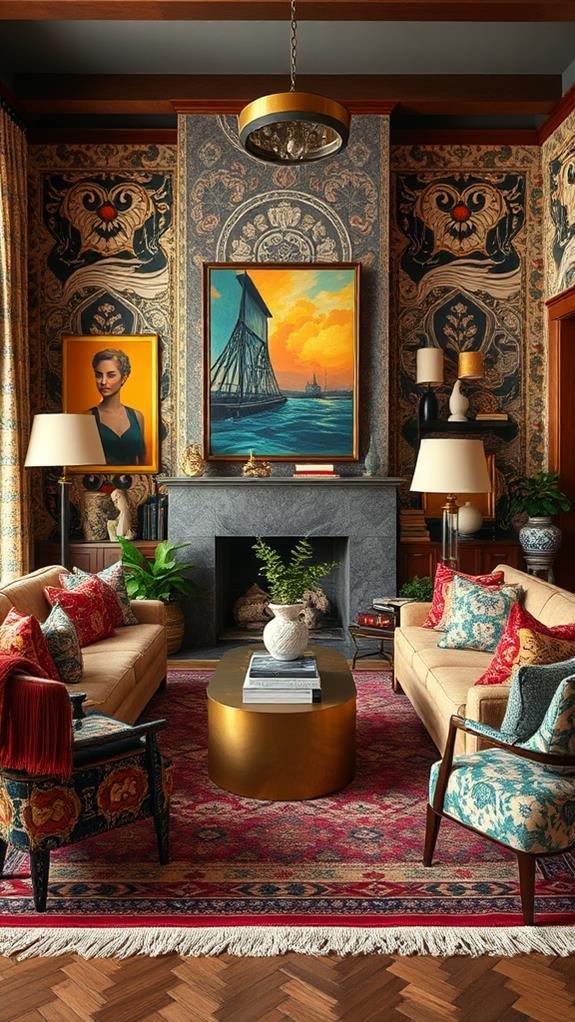Essential Elements of Spa Interior Design
When designing a spa, focus on essential elements like soothing color palettes, soft lighting, and natural materials. Select calming hues like muted greens or gentle blues to promote relaxation. Use warm, layered lighting to create inviting spaces, and incorporate natural elements such as wood and stone for a tranquil feel. Arrange furniture to encourage easy movement while maintaining privacy. Soft fabrics and textures add comfort, while welcoming reception areas set a calming tone. Finally, guarantee smooth flow between spaces for an enjoyable experience. Uncovering the right balance and details can make a big difference in your spa’s atmosphere!
Key Takeaways
- A soothing color palette with muted greens and warm neutrals promotes relaxation and unifies the spa’s decor.
- Soft, layered lighting enhances ambiance and allows for mood adjustments, creating a welcoming entrance.
- Incorporation of natural materials like wood and stone fosters a calming connection to nature and enhances the overall atmosphere.
- Water features, complemented by warm lighting, serve as focal points, contributing to a serene and soothing environment.
- Thoughtful furniture arrangement and privacy considerations ensure comfortable movement and an intimate spa experience for guests.
Color Palette Selection
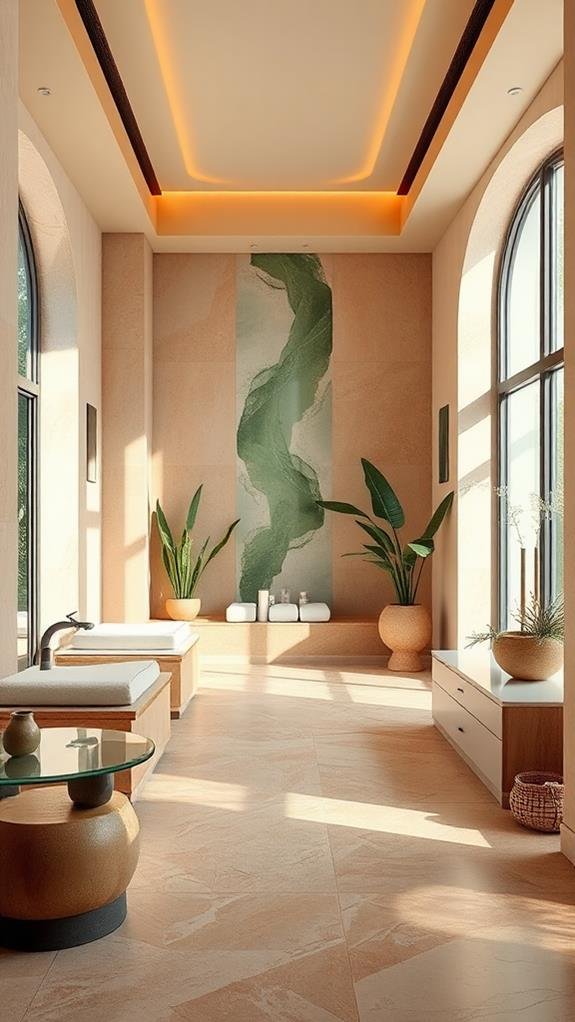
When creating a spa interior, selecting the right color palette is essential for setting the mood and enhancing the overall experience. Soft, soothing colors like muted greens, warm neutrals, and gentle blues can help you feel relaxed and at ease.
You might also want to reflect on incorporating earthy tones, as they often bring a sense of nature indoors. Your choice of colors can influence emotions, making it important to contemplate what feelings you want to evoke.
For example, cooler colors can promote tranquility, while warmer shades may encourage a more inviting space.
Remember, your color palette should create a cohesive look, blending seamlessly with your decor.
Lighting Strategies
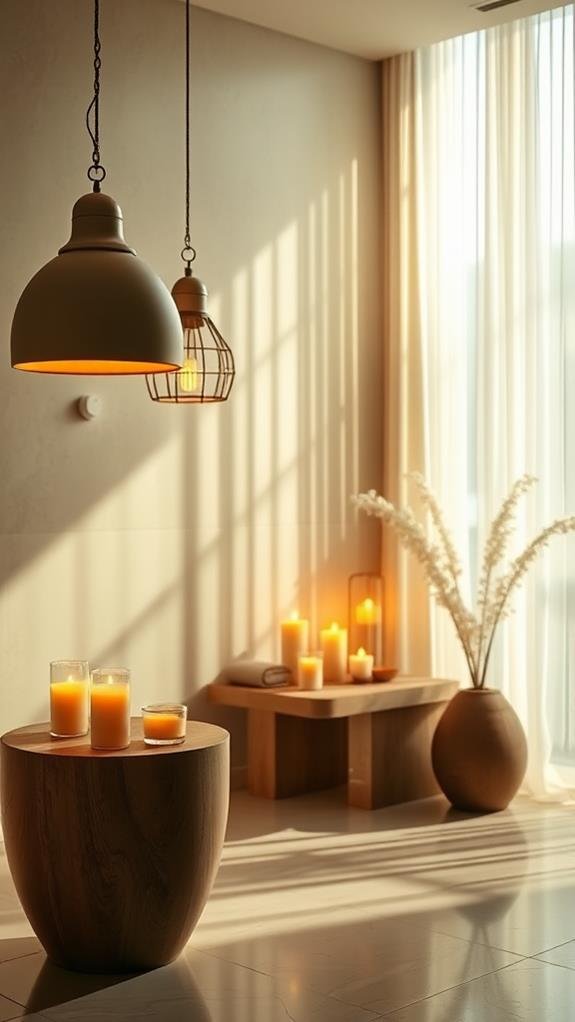
Good lighting can make all the difference in creating an inviting spa atmosphere. You want your guests to feel relaxed and pampered as soon as they walk in.
Start by using soft, warm lights that mimic natural daylight, helping to calm nerves. Layer your lighting by combining overhead fixtures with lamps and sconces, creating depth and warmth in the space.
Dimmer switches are a must—they allow you to adjust brightness based on the time of day or mood.
Don’t forget to highlight areas like treatment rooms and waiting areas, as these should feel especially serene.
Natural Materials
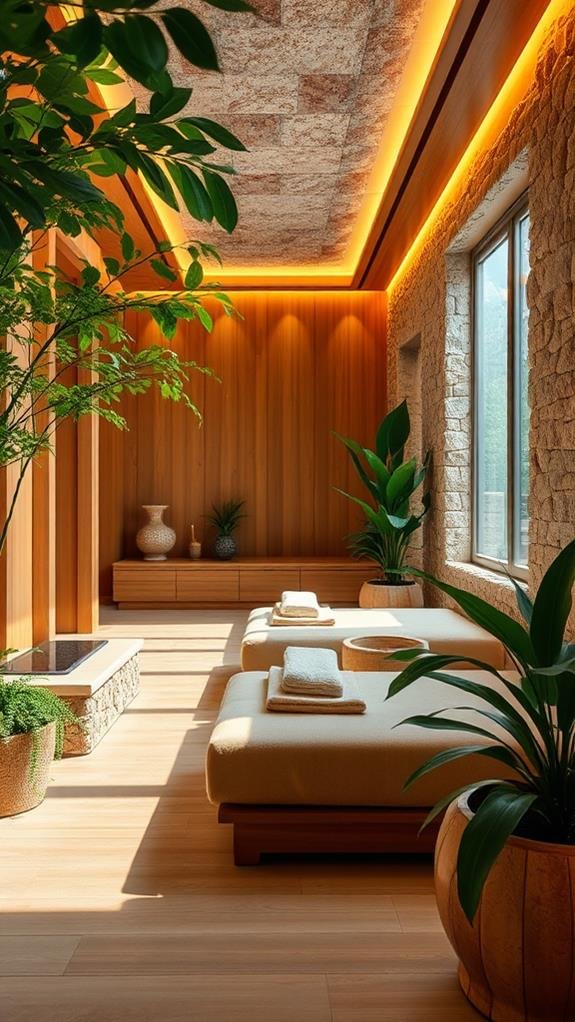
Creating a tranquil spa environment goes beyond lighting; incorporating natural materials plays a significant role in enhancing the overall ambiance. Using materials like wood, stone, and bamboo, you can create a soothing atmosphere that connects visitors to nature.
These elements not only look beautiful but also bring warmth and texture to the space. For flooring, consider warm wooden planks or smooth pebbles, as they feel pleasant underfoot and evoke a sense of calm.
You can also incorporate indoor plants to purify the air and add a touch of greenery.
Furniture Arrangement
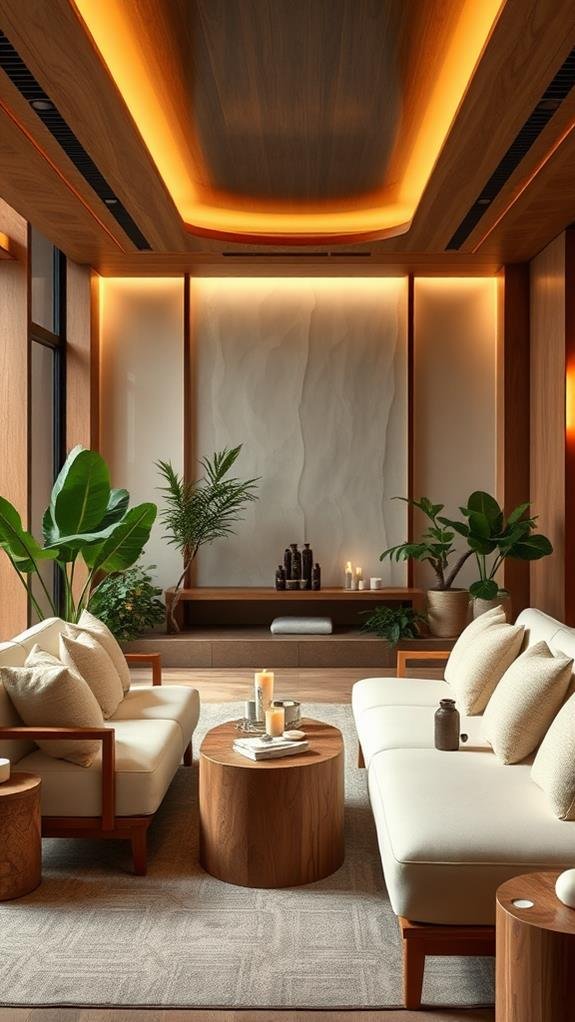
While it may seem straightforward, furniture arrangement is essential to fostering a serene spa environment.
You’ll want to think carefully about the layout to create a calm and inviting atmosphere. Start by positioning larger pieces, like treatment tables and seating, to encourage easy movement and accessibility. Leave enough space for clients to feel comfortable and relaxed.
Consider placing chairs in cozy, semi-private corners for quiet conversations or personal reflection. Use low-profile furniture to maintain an open feel, making the space seem larger and more airy.
Additionally, align the arrangement with any focal points, such as windows or artwork, to improve the overall aesthetic. A well-thought-out furniture layout helps you achieve that tranquil vibe every spa aims for.
Textures and Fabrics
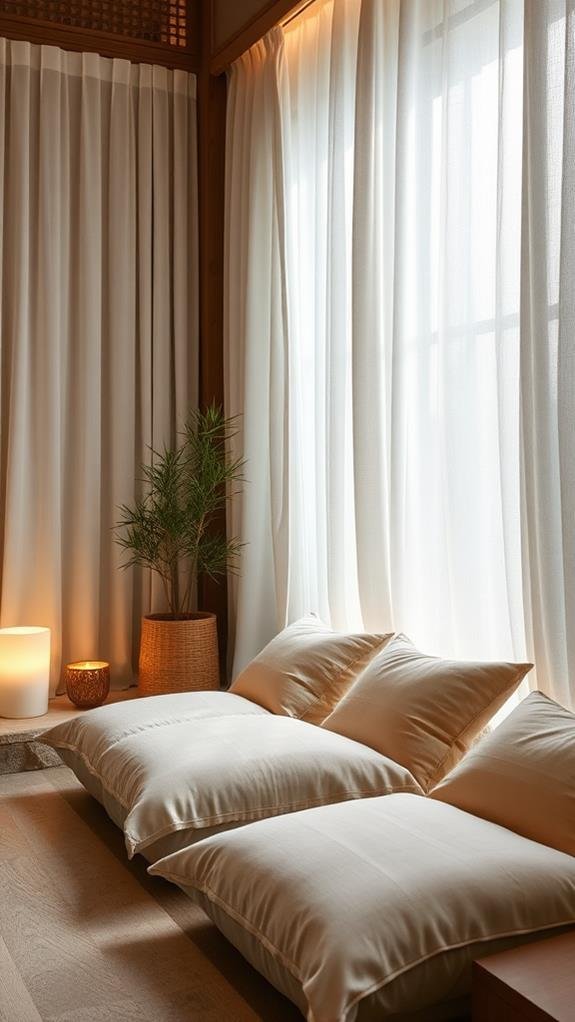
Textures and fabrics play an essential role in enhancing the overall ambiance of a spa. When you choose the right materials, you create an inviting atmosphere that encourages relaxation.
Soft fabrics like cotton or linen can provide comfort, while luxurious textures such as velvet or silk add a touch of elegance.
Don’t forget about layering! Combining different fabrics, like using plush rugs with smooth cushions, can make the space feel cozy and warm.
Colors also matter; calming hues promote tranquility, so consider pale blues or earthy tones.
Water Features
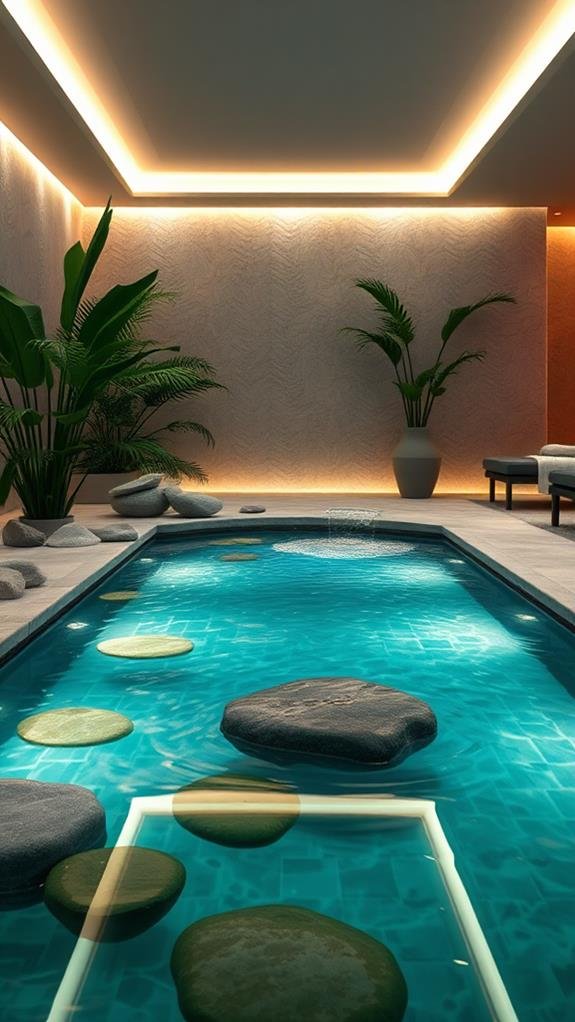
Water features are a signature element in spa interior design, instantly transforming the space into a serene oasis. You can consider a variety of options, like indoor fountains, soothing waterfalls, or tranquil ponds. These features create calming sounds, helping to drown out noise and promote relaxation.
When selecting water features, think about placement; central locations can become focal points, while smaller installations might fit nicely in corners. Additionally, lighting is essential. Soft, warm lighting can improve the beauty of the water and create a magical atmosphere.
Scent and Aromatherapy
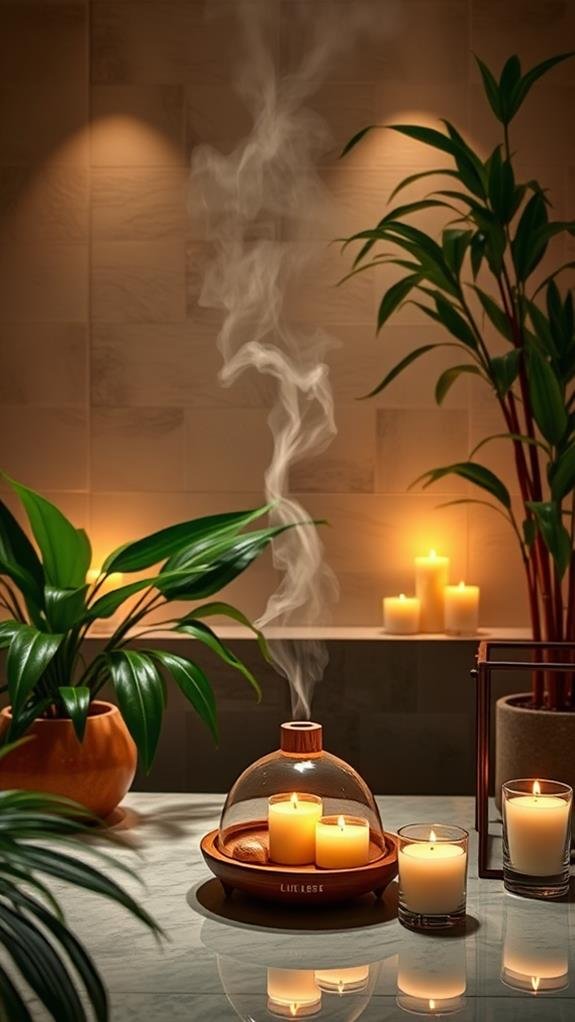
Scent and aromatherapy play an essential role in improving the spa experience, creating an atmosphere that soothes the mind and body.
When you enter a spa, you’re often greeted by calming fragrances that instantly relax you. Essential oils, like lavender and eucalyptus, can relieve stress and promote overall wellness.
You might notice diffusers or candles strategically placed throughout the space, releasing gentle scents that blend harmoniously.
These aromas not only uplift your mood but also enrich your treatments, making each moment feel special.
In addition, scents can evoke memories and feelings, helping you to connect with your inner self.
Sound Design
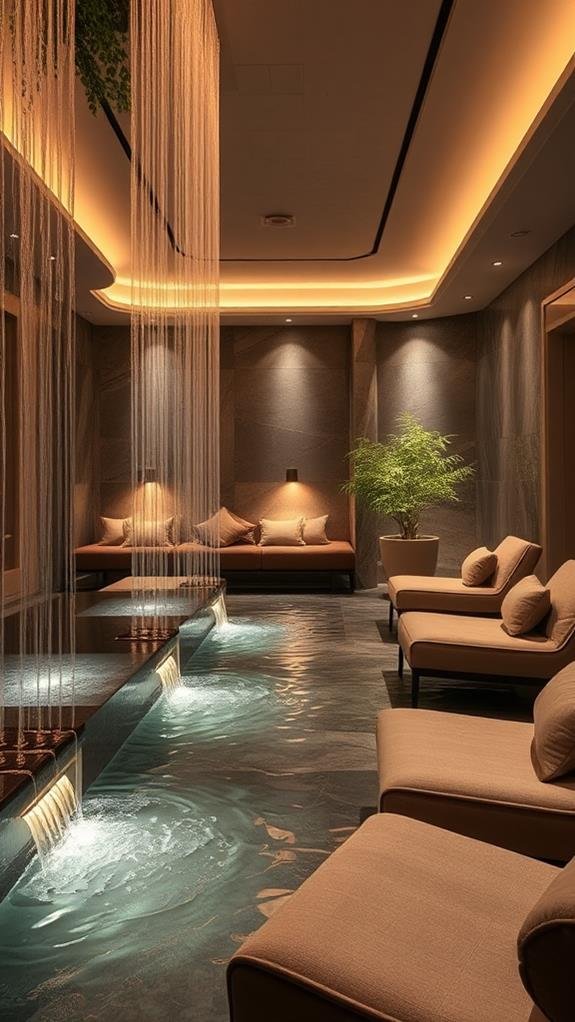
As you step further into the spa, the sounds envelop you in a serene hug. Gentle music plays in the background, creating a relaxing atmosphere that calms your mind.
You might hear the soothing trickle of water from a fountain or softly fluttering fabric, both designed to promote tranquility. Carefully chosen audio elements not only help you unwind but also improve your overall spa experience.
Alongside melodic tunes, silence plays an essential role, allowing you to welcome peaceful moments without distraction.
Consider the placement of speakers, ensuring sound flows evenly throughout the space. When done right, sound design helps you feel as if you’ve stepped into a world of relaxation, making your visit memorable and invigorating.
Greenery and Plants
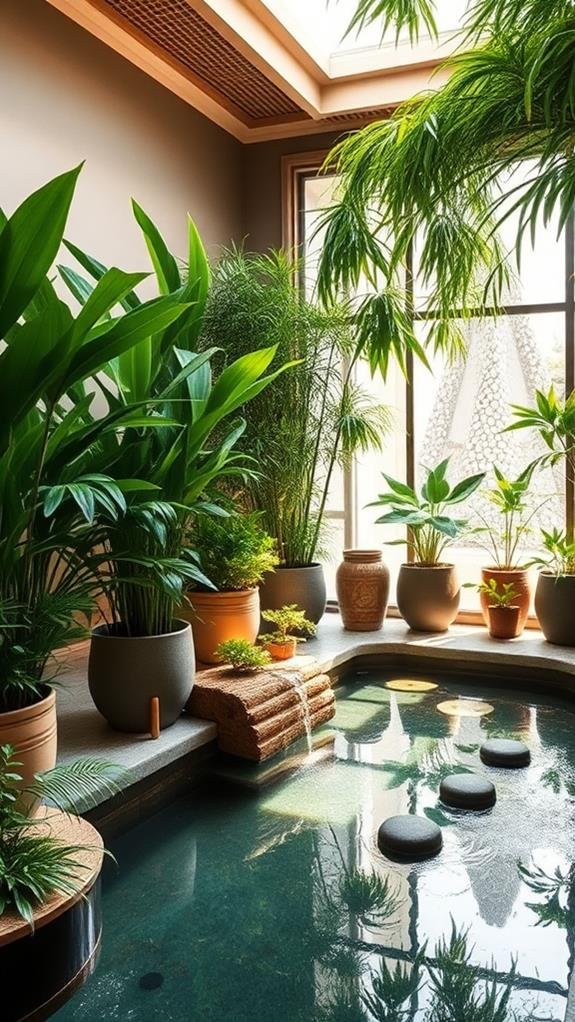
Incorporating greenery and plants often transforms a spa into a vibrant oasis of calm. These natural elements not only improve the aesthetic but also bring life to the space. By placing potted plants in key areas, you create a sense of warmth and serenity.
Consider using varieties like peace lilies or snake plants, which thrive indoors and purify the air too.
Hanging plants can add an artistic touch while maximizing floor space. Don’t forget about natural light; it encourages plant growth and improves the spa’s ambiance.
Additionally, the colors and textures of leaves provide a beautiful contrast to your design. Fundamentally, using greenery effectively can create a rejuvenating atmosphere, helping clients feel more relaxed and connected to nature during their spa experience.
Personalization Elements
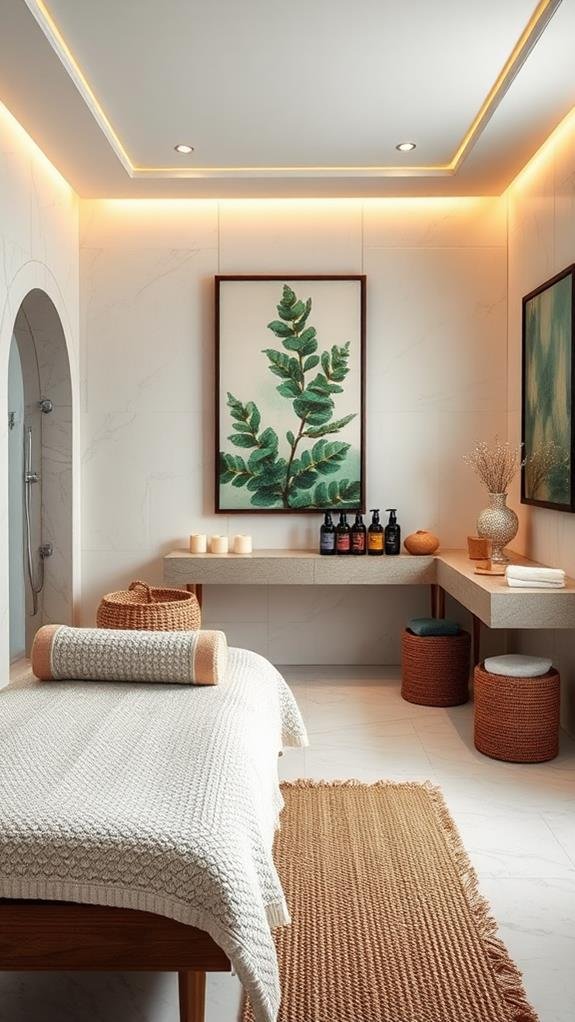
Creating a welcoming and bespoke environment in your spa improves the overall experience for your clients.
Personalization elements play a key role in making clients feel special and valued. You can start by tailoring treatment rooms with customizable options like adjustable lighting and soothing music that matches each client’s preferences.
Consider using a variety of scents in your essential oil diffusers, allowing guests to choose their favorite fragrances. Incorporating personal touches, such as welcome notes or customized wellness plans, shows that you care.
Ultimately, keep your staff trained to recognize and remember repeat clients’ preferences. All these details create a unique atmosphere that draws clients back, ensuring they feel at home while enjoying their spa experience.
Privacy Considerations
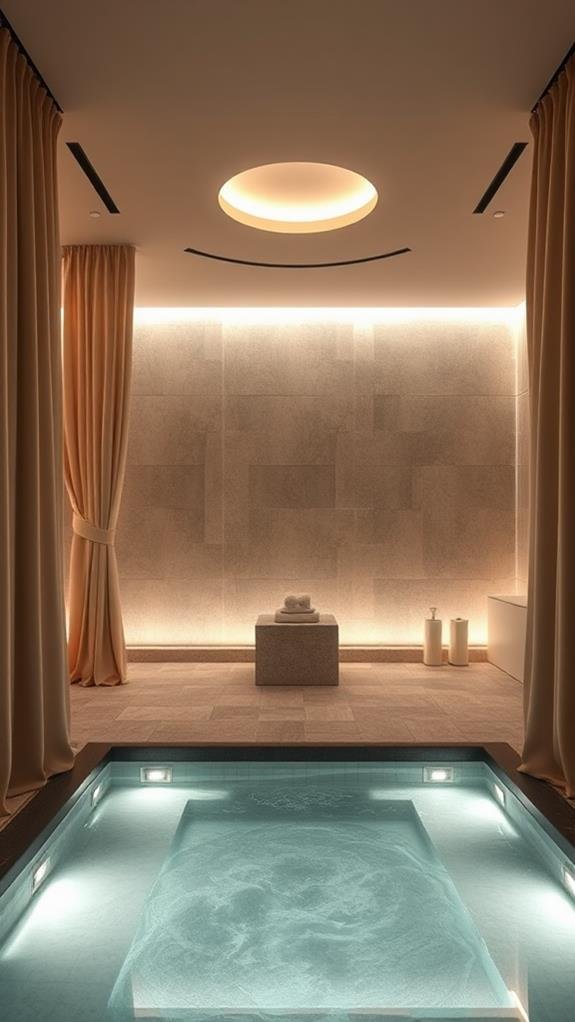
Ensuring a serene spa experience hinges on addressing privacy considerations for your clients. When designing your spa, think about how to create cozy, intimate spaces.
Use room dividers, curtains, or plants to separate treatment areas, offering clients a sense of seclusion. Soundproofing is also key; soft music or water features can help mask noises from other rooms.
Additionally, consider the layout of your spa. Avoid having treatment rooms located near busy areas like restrooms or waiting rooms, where distractions can disrupt relaxation.
Lighting plays a role too—use soft, adjustable lighting to improve comfort while minimizing exposure.
Reception Area Design
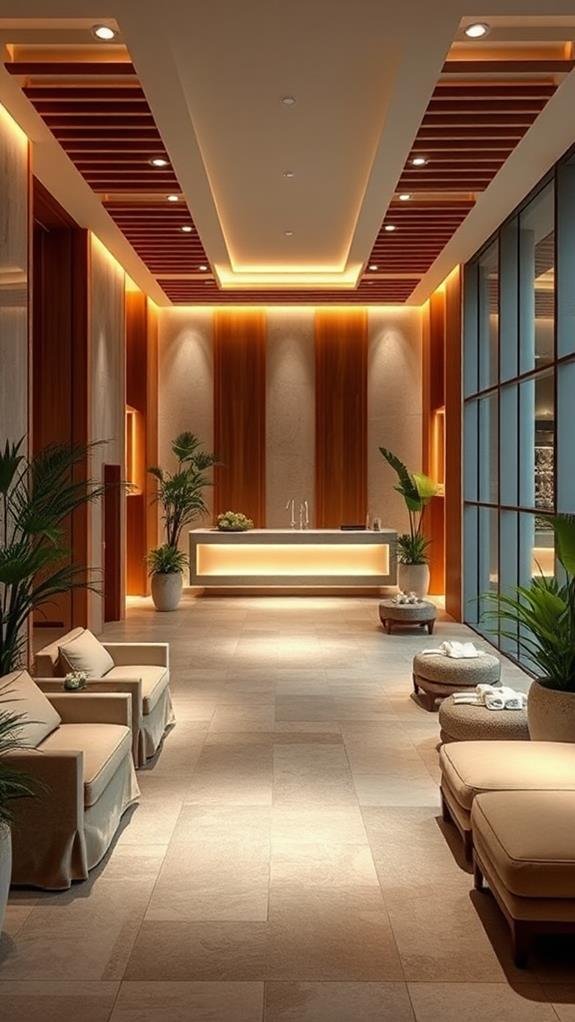
A well-designed reception area sets the tone for your entire spa experience.
When you walk in, soft lighting and calming colors immediately make you feel relaxed. Comfortable seating encourages guests to unwind as they wait.
You’ll want to add nature-inspired decor, like plants or water features, that promote tranquility. Having a welcoming reception desk, where friendly staff greet you warmly, is also essential.
Incorporating soothing background music can improve this atmosphere, helping you to disconnect from daily stress.
Remember, personal touches, like fresh flowers or an aroma diffuser, create a unique environment that feels inviting.
Treatment Room Essentials
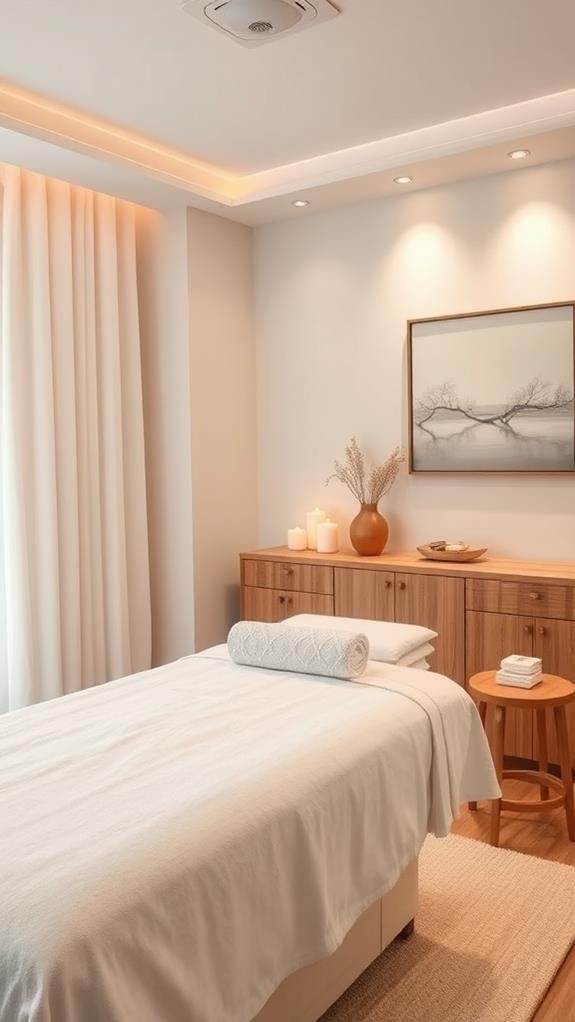
What elements truly transform a treatment room into a sanctuary of relaxation?
First, focus on comfortable treatment tables topped with soft linens that invite you to unwind.
Then, consider the lighting; dimmable options create a soothing ambiance, while natural light can uplift the space.
Soft, calming colors like pastels promote tranquility and ease tension.
Don’t forget about essential oils or soothing scents that can improve the overall experience, making the room feel inviting.
Additionally, sound plays an important role; gentle background music or the sound of water can help you relax more deeply.
Finally, make sure there’s storage for supplies, keeping the room neat and organized.
Flow and Space Planning
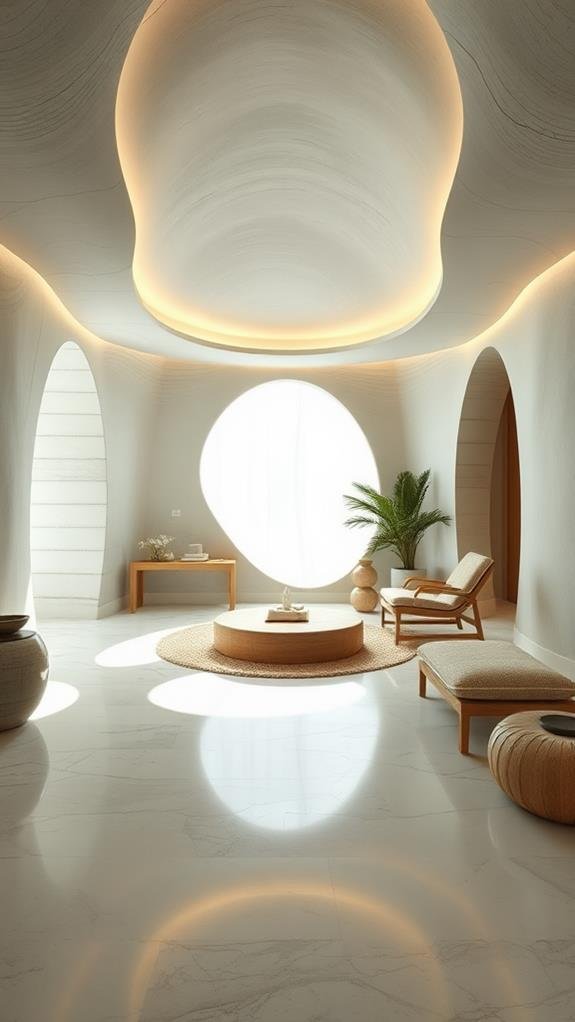
Creating a seamless flow in spa design is essential for enhancing the client experience. You want clients to feel relaxed and welcome as they move from one area to another. Start by considering how spaces connect, like the reception area leading smoothly to treatment rooms.
Using natural pathways can help guide guests without confusion. Confirm that common areas don’t feel cramped; instead, allow for comfortable movement.
Place furniture thoughtfully, so clients can easily find seating or relaxation spots. Remember, lighting and color can also impact flow; soft, soothing tones create a calm atmosphere.
Maintenance Considerations
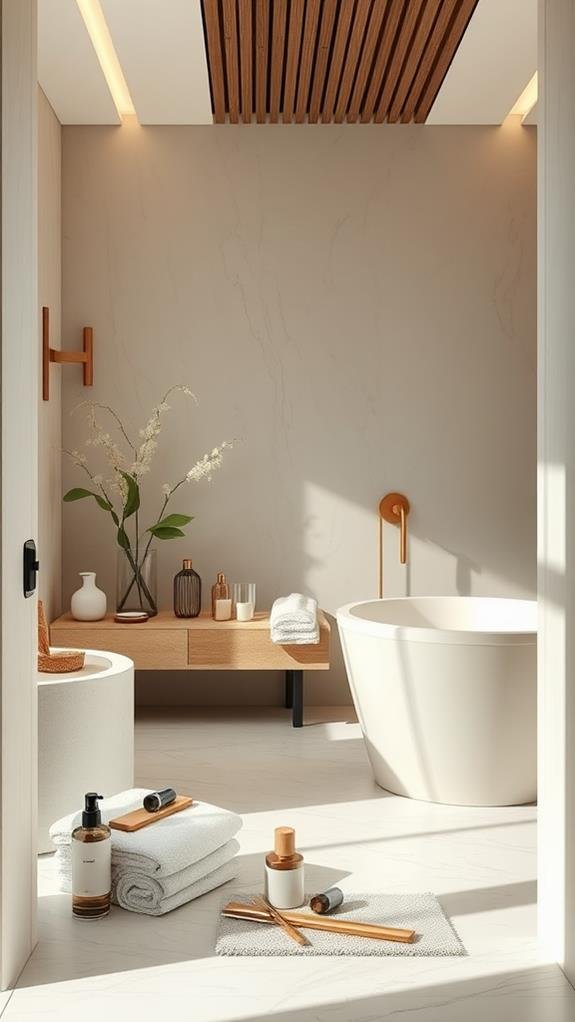
Regular maintenance is essential to keeping a spa looking pristine and ensuring a high-quality experience for clients.
You’ll want to regularly check and clean all surfaces, from floors to treatment rooms, to prevent buildup and maintain a welcoming atmosphere. Use durable materials that stand up to frequent cleaning, and consider the colors and textures that might show wear more easily.
Regular inspections of plumbing and lighting are crucial, too, as leaks and flickering lights can disrupt the serene environment you aim to create.
Don’t forget to train your staff on proper maintenance practices, as a well-informed team is key to preserving your spa’s appeal.
Prioritizing these tasks will keep your space comfortable, safe, and inviting for everyone.
Conclusion
In conclusion, creating a soothing spa interior involves thoughtful choices in color, lighting, and materials. By arranging furniture and selecting the right textures, you can improve both comfort and relaxation. Don’t forget the importance of a welcoming reception area and well-equipped treatment rooms. Careful flow and space planning guarantee a pleasant experience, while keeping maintenance in mind helps keep your spa looking its best. With these essential elements, you’re well on your way to designing a perfect retreat!


